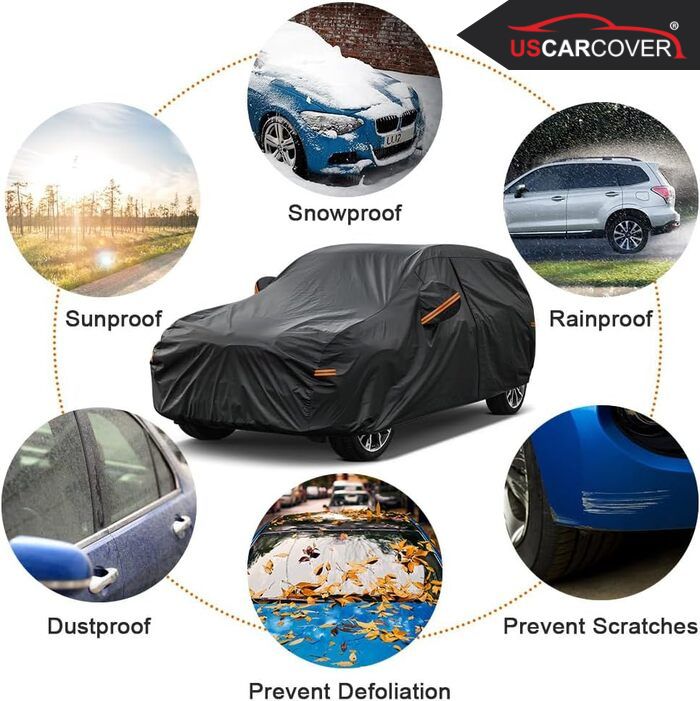
An Infiniti car cover is not just a simple tarp thrown over a luxury vehicle. Think of it as a mobile “microclimate” designed to control the four most common sources of outdoor damage: harsh sun and UV, rain showers and mineral spotting, windborne fine dust, and humidity including salty moisture. In the United States, a workday or a weekend beach trip can take your Infiniti across the scorching Sun Belt, the drizzly Pacific Northwest, the dusty Desert Southwest, or coastal zones heavy with sea air. When parked outdoors, each environment is a different stress test for deep-gloss paint, panorama glass, black plastics, chrome, rubber seals, and light-colored leather. Instead of waiting for damage and then “putting out fires” with polishing, de-spotting, or costly trim replacements, the proactive approach is to use a cover engineered around the physics of sun, water, wind, and salt. This article dives into each common failure scenario, explains why it happens, which symptoms you will see, and in detail how an Infiniti car cover cuts off the damage conditions at the source.
Related Articles: Ineos car cover: Always protect your vehicle in every harsh environment
Why being proactive starts with a cover engineered on the right mechanism
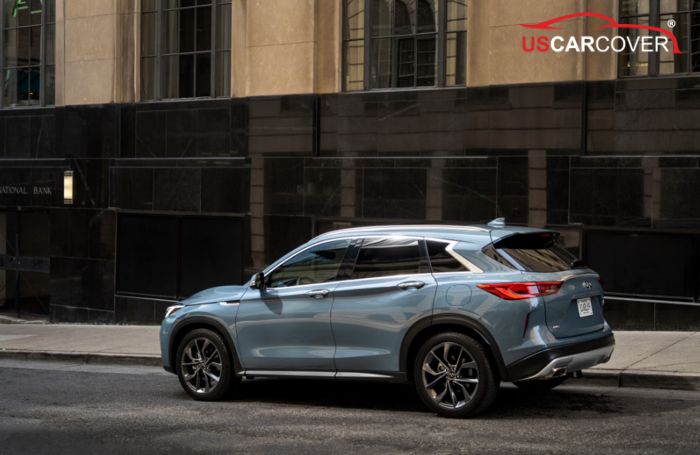
The very traits that make Infiniti desirable are also areas that need extra protection: large glass or a panorama roof creates an airy feel yet is a “gateway” for radiation and heat; sharp body lines and deep-gloss panels easily reveal micro-swirls; chrome and bright trim elevate luxury but are sensitive to salty humidity; light-colored leather and wood veneer are premium but tolerate heat poorly and can discolor. When parked outdoors, the chain of factors works quietly. UV breaks polymer bonds, graying black plastics. Heat pulls moisture from leather, fabric, and adhesives, drying and aging them. Water that lingers along glass edges evaporates and leaves white mineral frames. Fine dust plus wind under a loose cover turns into invisible sandpaper. Salty humidity trapped in a closed space accelerates pitting on chrome and exposed fasteners.
A true outdoor car cover for Infiniti does not solve problems with thickness alone. It relies on a coordinated set of mechanisms: a beading outer face that makes droplets leave quickly, a breathable core that lets vapor move upward instead of being trapped, an ultra soft liner that turns contact into a gentle touch, and a form-correct cut that keeps the cover still in wind. When those four work together, the conditions that form damage are eliminated at the start. That is genuine proactive protection.
Related Articles: Hyundai car cover: New fabric technology for sun, rain, snow and scratch protection
Harsh sun and UV: cool with radiant reflection, last longer with one-way ventilation

Most complaints about heat and fading come from two processes happening together. First, solar radiation passes through glass and is absorbed by interior surfaces that then release heat, especially the dash, screens, and light seats. Second, a dark, airtight cover absorbs radiation and bakes the underside, so the cabin keeps heating even with the engine off. Over time, leather dries and micro-cracks, wood veneer develops micro-fractures, black plastics fade, and rubber seals harden and emit harsh odors.
An effective UV-resistant car cover for Infiniti begins with a stable, reflective outer face to reduce heat load into the cabin. Next is a breathable core that allows warm, moist air to escape upward instead of being trapped. With heat and vapor routed correctly, lower cabin temperature follows immediately. You will feel a cooler steering wheel, brighter leather that holds tone, and screens and the dash suffering less thermal shock. With a panorama roof, the benefit is even more obvious because the roof glass is a major heat source. As a result, interior care intervals stretch out, yearly upkeep drops, and stepping into the car at noon becomes far more comfortable.
Quick application note for the Sun Belt: if parking for 30 to 90 minutes at midday, a half cover over glass and roof is enough to cut heat and block UV. For overnight or all-day outdoor parking, a full cover protects paint, glass, chrome, and seals comprehensively.
Related Articles: Hupmobile car cover: full coverage, interior protection, anti-mold and anti-rust to keep your car looking new
Showers, mineral spotting, and musty odors: shorten wet time and prevent a humid greenhouse
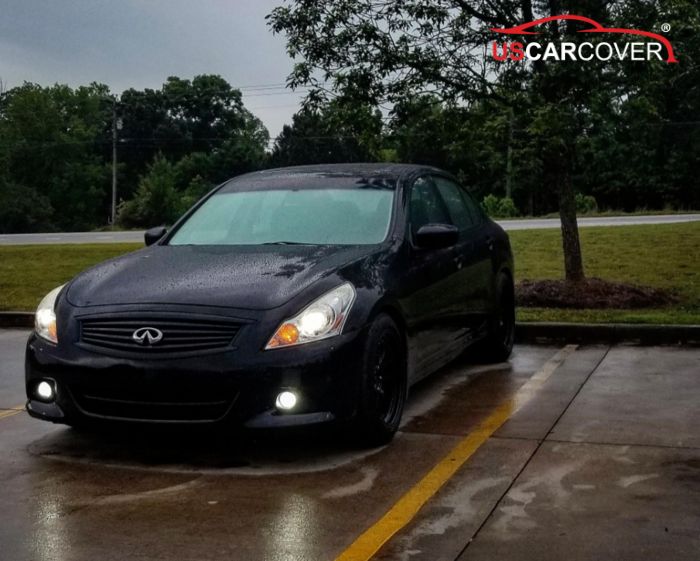
In the Pacific Northwest, rain is not always heavy but it lingers. In many neighborhoods, sprinklers run in the morning. The common outcome is droplets that sit at glass edges and trim. As they evaporate, minerals form those white frames that are difficult to remove. Meanwhile, if the space under a cover is sealed, it can stay clammy for hours. The cabin takes on a musty smell, and chrome or bright trim dulls faster.
The root-cutting mechanism has two parts operating together. A beading outer face makes water contract and roll away along glass and hood, shortening wet time. A breathable core provides a one-way path for vapor to leave from below, keeping the underside dry across days instead of cycling between dry and damp. When the cover stays still in wind thanks to a stable form, recessed seams, and soft hems, fine dust is not dragged across paint during windy showers.
Two small habits bring visible results within days: after a long rain, gently lift one corner for a few minutes to exchange air before closing the cover again. If your driveway uses sprinklers, schedule them when the car is not sitting there or cover the car before they run. The white rings along the glass edge will fade and disappear without daily scrubbing.
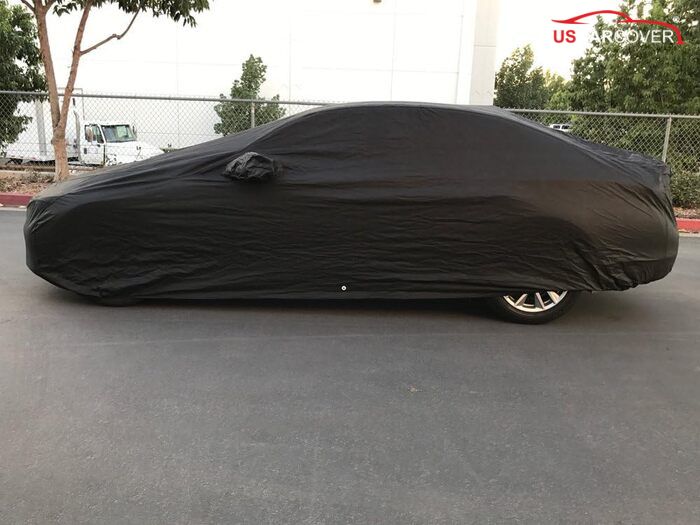
Related Articles: Hummer car cover for indoor or outdoor: choose based on needs, climate, parking context, and off-road frequency
Fine dust and strong wind: neutralize the “swirl machine” with form stability and a soft liner

In the Desert Southwest, the Great Plains, or construction-heavy neighborhoods, fine dust is daily life. A dust particle sitting still is mostly harmless; problems arise when a loose cover inflates and collapses with wind. Each inflate-collapse cycle drags dust sideways like an ultra-thin abrasive, leaving a web of micro-swirls on the hood, roof, and glass, especially visible on black or deep blue paint. Stop that “swirl machine” with an anti-scratch car cover for Infiniti that is cut to hug the specific geometry of sedans, crossovers, or SUVs. The cover suppresses air pockets at the nose and rear glass so it stays still in gusts. Recessed seams hide hard edges, soft hems prevent edge prints along glass and sharp creases, and an ultra soft liner turns all adjustments into cushioned contact. For short midday stops, a half cover over glass and roof lowers cabin temperature and limits dust entry. For overnight outdoor parking in windy areas, a full cover locks out the dust-plus-movement scenario entirely.
A quick, familiar rhythm that takes just one to two minutes can “save” the surface for the whole season: before covering, brush off larger grit on the hood and glass; when removing, give the cover a light shake so dust falls away before rolling it up.
Related Articles: Hillman car cover: preserve value and extend vehicle lifespan, reduce repair and maintenance costs
Humidity and salty air by the coast: break the salt incubator before pitting takes hold
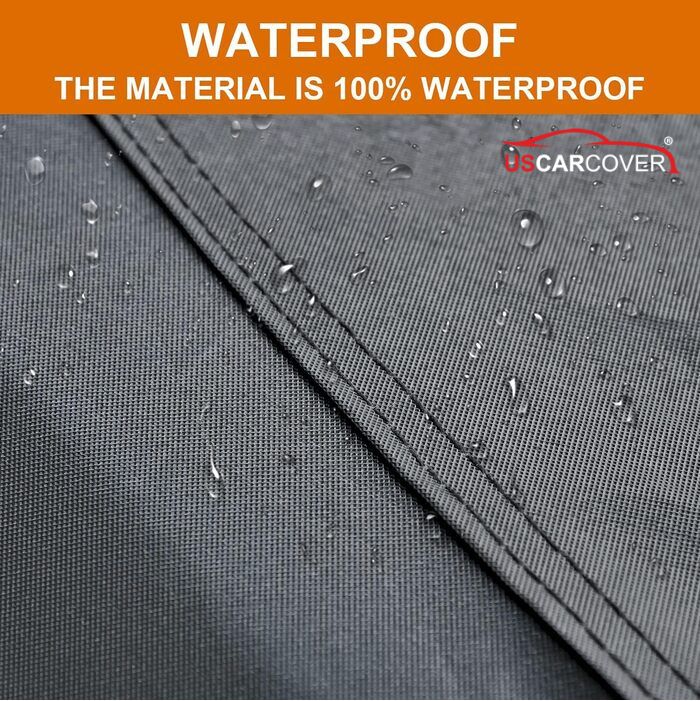
On the Gulf Coast, the Florida Keys, and along the Pacific, salty humidity is the main enemy. Salt is strongly hygroscopic. It clings to chrome, hinges, and exterior fasteners and, when trapped in a closed, humid space, accelerates pitting surprising quickly. Coastal wind often keeps covers moving, so salt particles rub like fine abrasives and wear surfaces out. In this context, a breathable car cover is mandatory. Its core must let vapor move upward, preventing a salty greenhouse under the cover. A beading outer face shortens time wet, and a stable form keeps the cover still in wind. Add two small but powerful habits: each time you remove the cover, shake off salt before rolling it up; after several coastal days in a row, give it a quick fresh-water rinse and dry it before storage. With that, chrome preservation becomes proactive maintenance rather than a cycle of emergency polishing.
Protecting interiors and premium surfaces: light leather, wood veneer, panorama glass, black plastics, chrome, and seals
Inside, light leather and wood veneer in many Infiniti models are sensitive to heat and UV. Outside, black plastics, rubber seals, large glass, and bright trim bear the first environmental impact. When an Infiniti car cover shades the roof and glass, radiation is cut substantially and the cabin cools faster. A beading surface prevents lingering water, a breathable core keeps the underside dry, and a stable form stops repetitive friction. The payoff is leather that holds tone, veneer with fewer micro-cracks, black plastics that stay dark, clear glass, deep chrome, and supple seals, with a cabin free of musty odors.
Related Articles: Hudson car cover: Scratch protection, rain beading, fast moisture release, lasting chrome shine, fewer water spots on glass
“Anatomy” of a good Infiniti car cover: four layers, one unified operating system
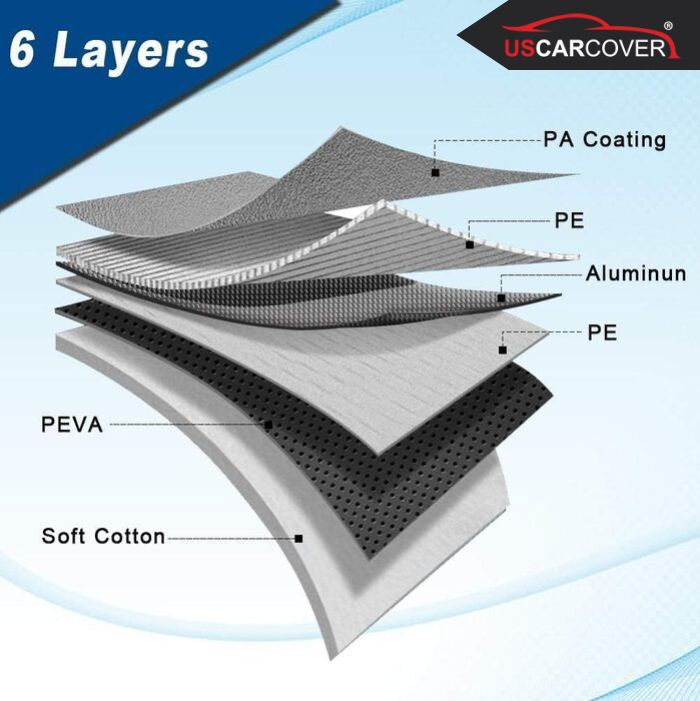
Do not view a cover as just thick fabric. See it as a four-layer build, each with a specific job:
- Beading outer face makes water bead and slide away along body slopes. With faster droplet departure, wet time shortens and conditions for spotting and corrosion do not develop.
- Breathable core uses a micro-porous network to route vapor from below to above. Rain outside does not wick inward, while interior humidity has a way out. Thanks to the one-way flow, the underside stays dry across days, preventing odor and micro-mildew.
- Ultra soft liner directly contacts paint, glass, and chrome and is safe for fresh paint, PPF, or ceramic-coated surfaces. The liner ends repetitive friction during every install and removal.
- Stable form with recessed seams and soft hems suppresses ballooning at typical hotspots, hides fabric edges, and keeps the cover still in gusts. That prevents “edge prints” on upright glass and long, flat roof sections.
These four layers are not marketing tricks. They are the practical mechanisms that make daily use natural. When a cover is easy to use, you use it often, and only then does protection truly compound week after week, month after month.
Choose an Infiniti car cover by U.S. climate and parking context
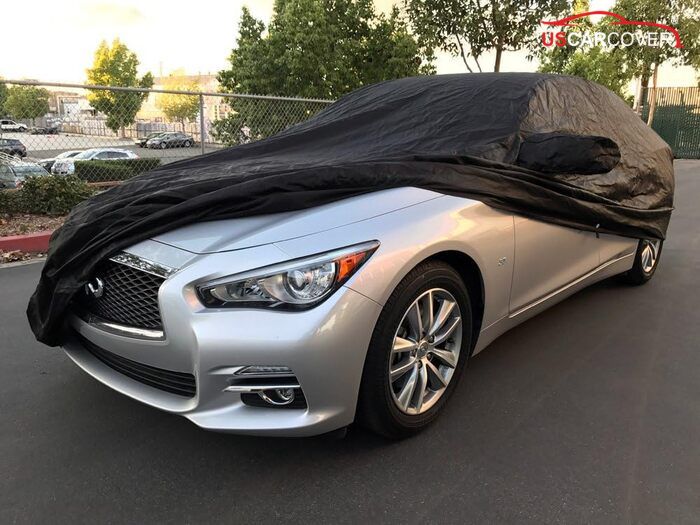
The first rule is not “thick or thin” but “where do you park most."
- Sun Belt: prioritize a reflective outer face and strong UV resistance; a breathable core to avoid heat-plus-humidity buildup; if the car has a panorama roof, shade it well to lower cabin temperature.
- Pacific Northwest: look for stable beading to eliminate glass-edge frames and reliable breathability to keep the underside dry and prevent musty odors.
- Gulf Coast and coastal zones: true breathability is non-negotiable to break the salty greenhouse; add the routine of shaking off salt and occasionally a fresh-water rinse after many consecutive days.
- Great Plains and the Rockies (windy): a stay-still form, sensible anchor points, recessed seams and soft hems so edges do not print on curved glass.
- Northeast and Midwest (four seasons): balance strong beading, breathability, and wind stability; during road-salt season always shake off salt before storing the cover.
Getting the context right from day one avoids buying an overly thick but airtight cover for humid, salty regions or a cover too light for blade-like winds
Related Articles: Honda car cover: rain resistant, strong UV protection, cooler cabin, durable paint and interior
Cost angle: prevention is cheaper than repair
A season-end package of swirl removal, glass de-spotting, and chrome correction often equals or exceeds the cost of a quality Infiniti car cover. If you already invested in PPF or ceramic coating, skipping a properly engineered cover effectively shortens the life of that premium protection. A custom-fit Infiniti car cover safeguards paint and interior and also protects your detailing investment.
Related Articles: How to choose a GMC car cover for Urban areas, the Sun Belt, the Snow Belt, coastal regions, and high-wind plateaus
Where to buy a trustworthy Infiniti car cover

A good cover is one you are willing to use every day. That means the seller should understand U.S. climates, parking habits, and each model’s geometry, not just ship a product. US Car Cover fits Infiniti owners well because it focuses on features that matter in real use: a stable beading outer face, a truly breathable core, an ultra soft liner safe for fresh paint, PPF, or ceramic, and a form-correct cut that keeps the cover still in wind without over-tightening. You also get guidance by region such as the Sun Belt, Pacific Northwest, Gulf Coast, Snow Belt, and high-wind plains, with instructions for the clean, dry, light, stable routine. When the mechanism and the form are right, each install and removal becomes quick, tidy, and clean, and because it is easy, you will use it often. That is the key to lasting protection.
One fabric system, four tasks, one goal
A worthwhile Infiniti car cover is not about thickness. Its real value lies in four tasks working in harmony: beading to shorten wet time, breathability to break the humid greenhouse, ultra soft liner to stop repetitive friction, and a stable form to remain still in wind. When these four pieces run as one mechanism, the conditions that form damage are removed. The result is your Infiniti aging more slowly through seasons of harsh sun, showers, fine dust, and salty humidity. Choose correctly and use it correctly, and harsh environments become mere background while your vehicle’s beauty and value stay with you much longer.
